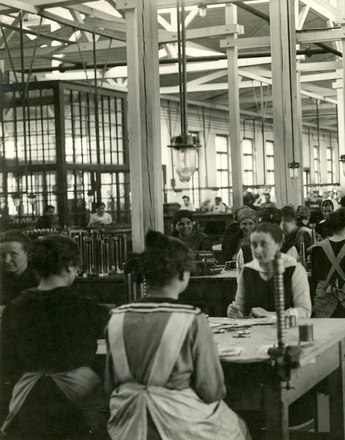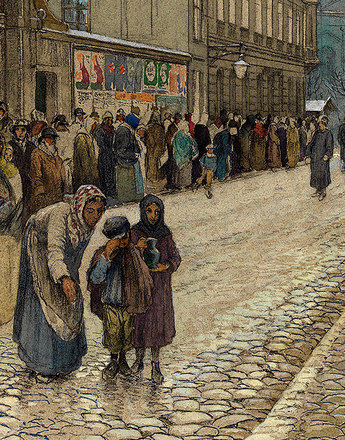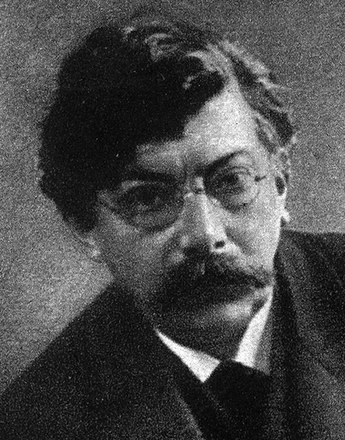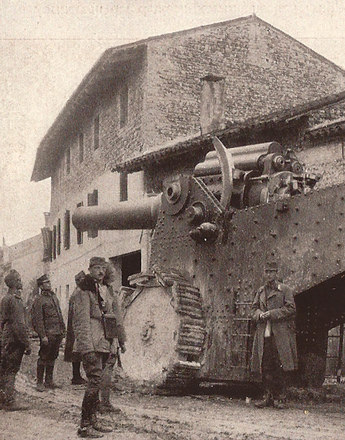Even before the war the Imperial and Royal Artillery Arsenal was a large state-owned armoury. During the war it experienced a huge expansion. Up to 20,000 workers were employed in eighteen factories not only with the production of new arms but also with the repair and recycling of weapons.
The Imperial and Royal Artillery Arsenal, which was run by the military, had a special role to play in the Vienna armaments industry as an artillery factory and armoury. It expanded during the war to become a weapons acquisition facility of unparalleled size. Whereas it employed 2,600 workers before the war, during the war the workforce rose to 20,000, including 14,000 civilians and a considerable number of Landsturm workers. Even at the end of the war, it still employed around 12,000 people.
During the war, eighteen major factories were making equipment for the army in the Arsenal. To permit this expansion in armaments production the original thirty buildings had to be supplemented by a further 138 new ones as well as 93 wooden barracks. It made field and siege artillery of different calibres, and defence and siege mortars. Artillery made elsewhere was assembled in the Arsenal, and it also served as a repair shop for captured weapons, which were cannibalised to make new ones.
A report at the time described the round-the-clock war machinery: “On the outskirts, behind the brick walls of the Arsenal, the banging and hammering are constant. Damaged artillery, broken machine guns and train wagons and other bent, smashed and blown-up equipment from the major battles in all theatres of war are made fit for service again. Streams of molten bronze hiss and steam through mysterious channels, steam hammers crash down onto hot metal, circular saws screech and chips fly. All kinds of secret work takes place here out of the public eye, and their results – be it a bale with halters for horses, or complicated guns – leave the reinforced gates packed in wool, unrecognisable under the waterproof tarpaulins. An army of well drilled men work under strict conditions in shifts, and a horde of skilled and experienced engineers, artillerymen and other experts supervise, design and optimise. An iron will reigns, a relentless sense of duty, that allows room only for a modicum of rest and relaxation …” (Neues Wiener Tagblatt, 9 January 1916).
Even in the Arsenal, however, the mood of the workers began to change from May 1917 on account of the increasingly precarious food situation. Industrial action was avoided until the major wave of strikes in January 1918, and even then they didn’t last long, thanks to the calming influence of Victor Adler, leader of the Social Democrats. Arms production functioned in principle in the Arsenal until the end of the war. Thereafter a workers’ defence force protected the stocks from looting and theft, and the armoury was taken over by the Volkswehr [people’s militia] in the young republic.
Translation: Nick Somers
Neck, Rudolf: Arbeiterschaft und Staat im Ersten Weltkrieg 1914-1918 (A. Quellen). I: Der Staat, Band 2: Vom Juni 1917 bis zum Ende der Donaumonarchie (Veröffentlichungen der Arbeitsgemeinschaft für Geschichte der Arbeiterbewegung in Österreich 4), Wien 1968
Schubert, Peter/Schubert, Wolfgang: Das Wiener Arsenal, Klosterneuburg o.J.
Strauß, Ferdinand: Industrielle Betriebe, in: Dorn, Klemens (Red.): Favoriten. Ein Heimatbuch des 10. Wiener Gemeindebezirkes, Wien 1928, 116–161








